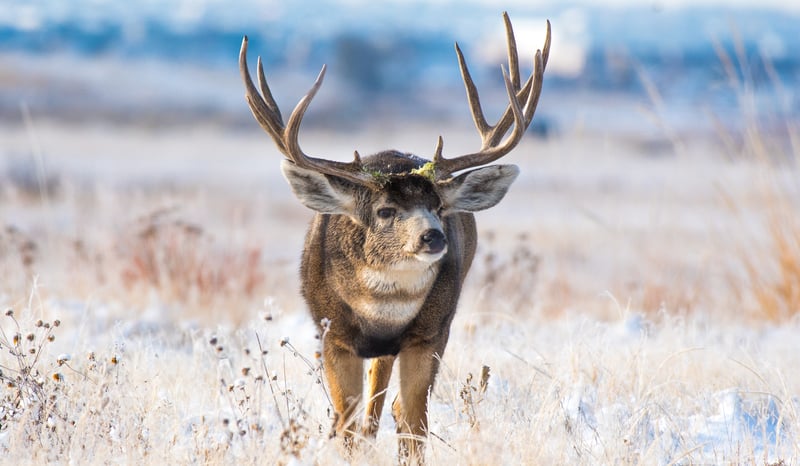Have you ever wondered if that deer you are looking at is a mule deer or a whitetail? There are some fundamental similarities and differences between the two species. This article will outline them and help you become more competent at identifying which species of deer you are looking at in the field.
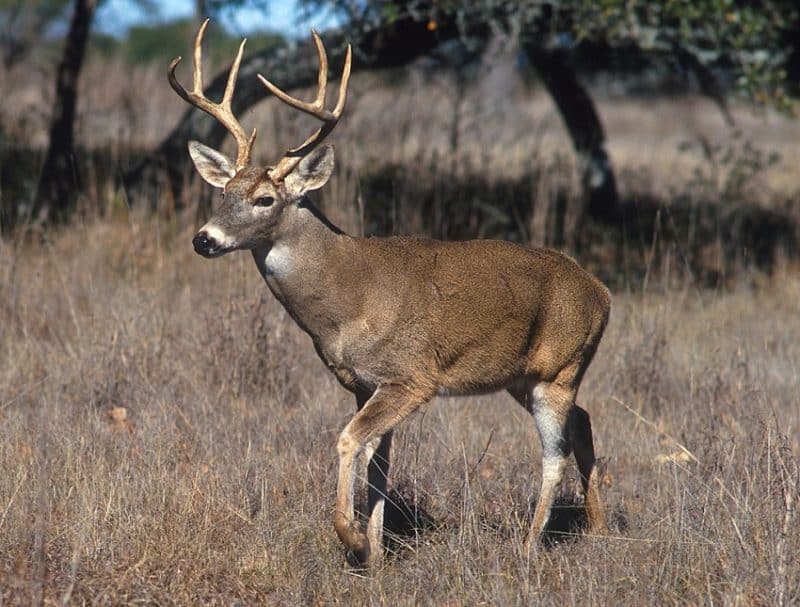
Range
Many areas only have one species or the other. Mule deer are iconic to the mountains and big open sagebrush country of western North America. On the other hand, Whitetails are more endemic to the farm fields and woodlots of the Midwestern and the eastern U.S and Canada. They also range as far south as Panama.
Areas Where Their Range Overlaps
There are areas where the two specie’s range overlaps. For instance, Whitetails live in the valleys of the Rocky Mountains from Wyoming and Idaho northward, as do Mule Deer. Additionally, both Mule Deer and Whitetails live on the prairies of Alberta and Saskatchewan. Also, Couse Deer, a subspecies of White-Tailed Deer, shares the same range with Mule Deer in Arizona, New Mexico, and Mexico.
Body Size
Different environments with differences in available nutrients produce differences in the body size of deer. In some areas, animals will not have the opportunity to grow to their genetic potential. In other areas, they will.
Having said that, though, if all environmental factors are equal, Mule deer will be larger than White Tails.
- Mule Deer- According to the Rocky Mountain Mule Deer Foundation, Mule deer are from 3 to 3-1/2 feet tall at the shoulder and 4-1/2 to 7 feet long. They weigh between 130-280 pounds. A trophy-sized buck will weigh well over 300 lbs.
- White-tailed Deer– An averaged sized White-Tailed buck weighs 150 lbs, while an average-sized White-Tailed doe weighs 100lbs
- Couse Deer– A Couse buck rarely weighs over 100lbs.
Coloration
- Mule deer– In the spring, Mule Deer shed their winter hair. Underneath, they are growing their summer coat which is tan in color. “Compared to a whitetail, a Mule Deer’s summer coat is a lighter tan.” They repeat the same process by shedding their summer hair and growing their winter coat in the fall. Their winter coat is longer and thicker and is grey in color. “Again, compared to a Whitetail, a Mule Deer’s winter coat is a lighter grey. At the rump, Mule Deer have a white to cream-colored patch that starts just above the top of the tail and extends out onto each hind quarter and then down to the bottom of the tail. A mature Mule Deer’s tail is approximately six inches long. Their tails are white with a black tip. In the winter, Mule deer have a black or dark grey patch that begins between their ears and extends down onto their forehead; from there, they are lighter grey to white down to their noses. They also have a white throat patch. In contrast, a White Tail has very little white on its face.
- White-Tailed Deer-White Tailed Deer go through the same process of shedding their Summer and Winter coats that Mule Deer do. Their Summer coat is tan, and their Winter coat is grey. Compared to a Mule Deer, though, both of their color phases are darker, and they have a reddish tinge to their hair that Mule Deer don’t have. White Tails have a narrow white patch at the rump that is hidden by their tails until they are alarmed. When a Whitetail is alarmed, they raise their tails as a signal of danger. This exposes their white rump patch and the white beneath their tails. A mature White Tail has an approximately 8-inch long tail that is fluffy in appearance. Their tails are tan on top and white underneath. A White-Tailed Deer’s face has very little white compared to a Mule Deer’s. They do have some white highlights around the eyes and nose and a white throat patch.
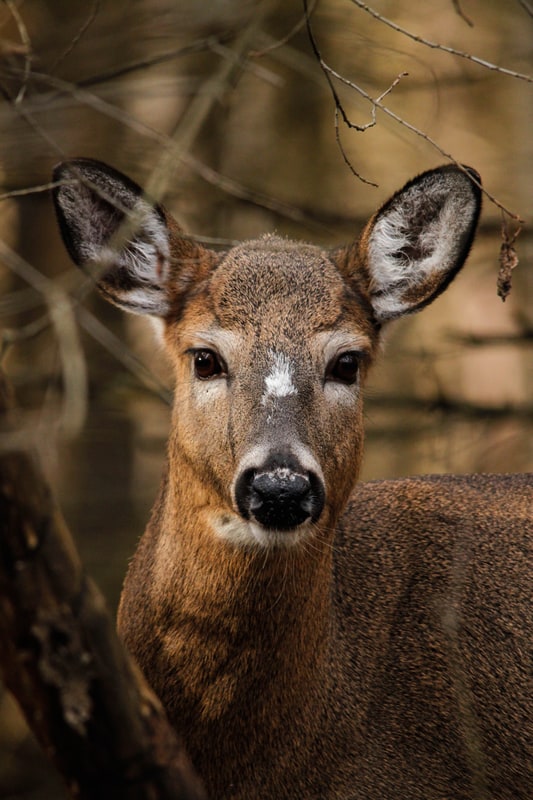
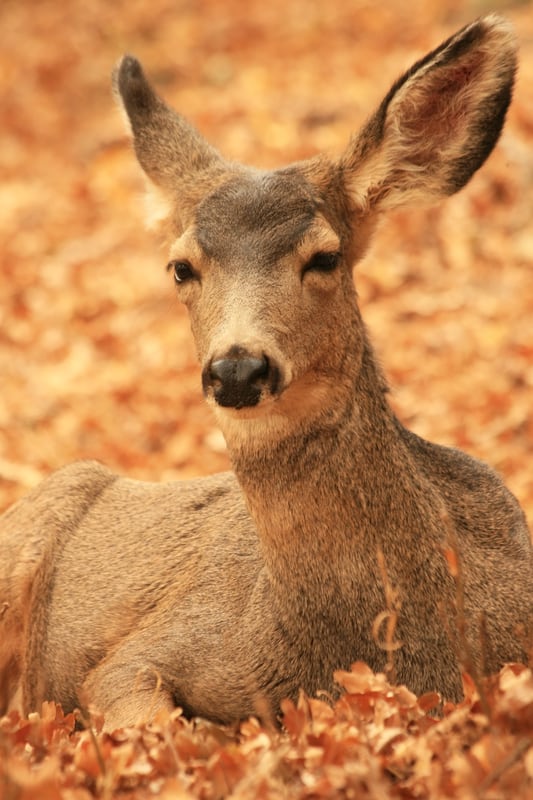
Ears
- Mule Deer– When you see a Mule Deer’s ears, you’ll understand why they’re called Mule Deer. A Mule Deer’s ears are long and wide in proportion to their faces. Each ear is, in fact, around 3/4 the length of their face. A mature Mule Deer buck will measure anywhere from 21 to 25 inches from the tip of one ear to the tip of the other.
- White-Tailed Deer– A White-Tailed Deer’s ears are small compared to those of a Mule Deer. A mature White-Tailed buck’s ears are around six inches long and anywhere from 16 to 18 inches from the tip of one ear to the tip of the other.

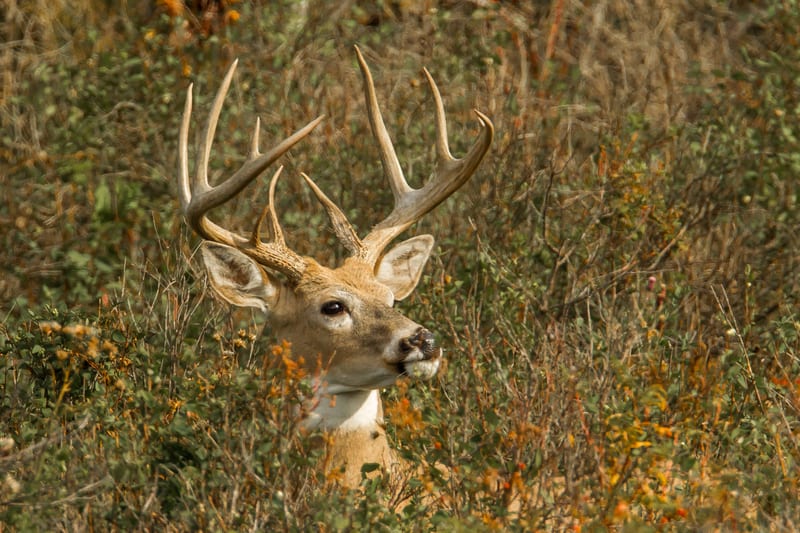
Antlers
- Mule Deer-A mature Mule Deer buck’s antlers are bifurcated. In other words, they branch into two main beams. The antler points branch out from these two main beams. A Mule Deer Rack that is classified as a typical has two main beams. The two main beams each fork into two points. In other words, each antler has four points. Each antler also may or may not have a brow tine. A non-typical Mule Deer buck’s antlers are also bifurcated into two main beams, but from there, the main beams fork into multiple points that in some cases poke out in all directions.
- White-Tailed Deer– A mature White-Tailed buck’s antlers each have a single main beam. For this reason, they’re easy to differentiate from those of a Mule Deer. A set of typical White Tail antlers will have four points plus a brow tine branching from each single beamed antler, and each antler will be fairly symmetrical in size to the other. The antlers of a non-typical White-tail are also single beamed, but they have multiple points branching out in an asymmetrical fashion.
How Do They Run?
- Mule Deer– Mule Deer are capable of galloping when they decide to. Most of the time, though, when they need to cover ground fast, they do so with a leaping bounding gate where all four feet leave the ground at the same time. This is known as stotting. With each stotting bound, a mule deer may jump as high as two feet and as far as fifteen feet.
- White-Tailed Deer– White-Tailed Deer use a galloping run when they need to cover ground quickly.
Intelligence
- Mule Deer– Mule deer have the reputation of being easy targets for hunters as compared to White Tails. I believe this is unjustified. Juvenile bucks, does, and fawns of the Mule Deer race have a higher tolerance for human presence than White-Tails probably do. However, mature Mule Deer bucks are some of the most elusive and intelligent animals on earth. They are rarely ever seen until rutting season rolls around. They then materialize out of thin air and gather up a harem of does. When the rut ends, they disappear back into the alternate dimension that they came from.
- White-Tailed Deer– White Tails justifiably enjoy a reputation for elusiveness and intelligence. Whether or not they are smarter than Muleys probably depends on who you ask.
In Conclusion
Get out there now and start spotting some deer! If you haven’t been sure which species you were looking at in the past, this article will have cleared that up for you.
Recent Posts
The only venomous snakes in Washington State are Northern Pacific Rattlesnakes. The Northern Pacific Rattlesnake (Crotalus oreganus oreganus) is a sub-species of the Western Rattlesnake. Anyone...
Skunks are not classified as true hibernators. But they go into a state of torpor when the weather gets cold. Skunks are light sleep hibernators, along with opossums, bears, and raccoons. ...

